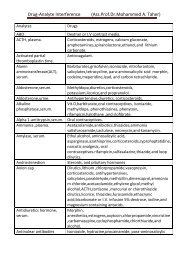Phytochemical Study of Cynara scolymus L. (Artichoke) (Asteraceae ...
Phytochemical Study of Cynara scolymus L. (Artichoke) (Asteraceae ...
Phytochemical Study of Cynara scolymus L. (Artichoke) (Asteraceae ...
You also want an ePaper? Increase the reach of your titles
YUMPU automatically turns print PDFs into web optimized ePapers that Google loves.
Iraqi J Pharm Sci, Vol.21(1) 2012 <strong>Phytochemical</strong> study <strong>of</strong> cynara <strong>scolymus</strong> L.cultivated in Iraq<br />
In North <strong>of</strong> Iraq and Kurdistan the<br />
people are used to eat the carpel <strong>of</strong> blooms (2) ;<br />
because <strong>of</strong> its nutritional value.The leaves <strong>of</strong><br />
C. <strong>scolymus</strong> are characterized by the<br />
composition and high content <strong>of</strong> bitter<br />
phenolic acid compounds whose choleretic,<br />
hypocholestremic and heptatoprotective<br />
activity attributed (4) . At least to the antioxidant<br />
potential <strong>of</strong> artichoke extracts and <strong>of</strong> their<br />
phenolic compounds. Constituents which are<br />
around 2% such as: caffeic acid, chlorgenic<br />
acid and cynarin, flavenoids (0.1 – 1 %) and<br />
essential oil<br />
(4) . Pharmacological studies<br />
demonstrated that the extracts <strong>of</strong> C. <strong>scolymus</strong><br />
and active principle cynarin (1,3 di-caffeoyl<br />
quinic acid ( C25H24O11 ) posses choleretic and<br />
hypocholesterolemic activity (5) .The extract <strong>of</strong><br />
the plant also protect hepatocytes treated with<br />
carbontetrachloride (CCl4) from hepatic<br />
cellular necrosis. This activity related to the<br />
power antioxidant effect <strong>of</strong> phenolic acids (6) .<br />
Recently pharmacological investigations and<br />
clinical reports published showed the efficacy<br />
and safety <strong>of</strong> artichoke extracts in treatment <strong>of</strong><br />
hepatobiliary dysfunctions and abdominal<br />
pain (7) .<br />
<strong>Cynara</strong> <strong>scolymus</strong> leaves<br />
<strong>Cynara</strong> folium is the whole drug;<br />
consist <strong>of</strong> the dried or fresh basal leaves with<br />
coarsely toothed margin.The cut drug is<br />
composed <strong>of</strong> grayish green, tomintose and fleet<br />
like aggregate with pithy fragment <strong>of</strong> petioles<br />
and nervature as well as very long fine fibers.<br />
The lower leaf surface is densely pubescent,<br />
grayish and matted with pinnate venation. The<br />
upper leaf surface is glabrous and green (2) .<br />
The plant thistle – like <strong>Cynara</strong> <strong>scolymus</strong> is<br />
perennial herb about 1.5 meter height; with<br />
pinnatified leaves 8 – 15 cm with wide flower<br />
head has obtuse – ovate fleshly involucres<br />
bracts (3) ; the pharmaceutical grad material<br />
consists exclusively <strong>of</strong> basal leaves, which up<br />
to 50 cm long and 25 cm wide; the deeply<br />
pinnotified leaf laminas is rarely entire<br />
margined but from flat, lance late segment<br />
with crossly serrate or finely toothed<br />
margin.The Iraqi plant has thrown margin. No<br />
regular cultivation was adopted in Iraq.<br />
The chemical constituents <strong>of</strong><br />
leaves <strong>of</strong> <strong>Cynara</strong> <strong>scolymus</strong><br />
The chemicals which from<br />
important constituent <strong>of</strong> C. <strong>scolymus</strong> include<br />
three classes. (8,9,10) :<br />
1. Phenolic acids which include a<br />
combinations <strong>of</strong> caffeic acid and quinic<br />
acid. C. <strong>scolymus</strong> have the two important<br />
anti oxidant cynarin and chlorogenic acid,<br />
by the combination <strong>of</strong> 1, 3 – 0 – quinic<br />
acid with two molecules <strong>of</strong> caffeic acid to<br />
7<br />
from 1, 3 - di – 0 caffeoyl quinic acid<br />
(cynarin) and 5 – 0 – caffeoyl quinic acid<br />
(chrogenic acide).<br />
Quinic acid<br />
Caffeic acid<br />
Chlorogenic acid<br />
Cynarin<br />
2. The flavenoids particularly glycoside <strong>of</strong><br />
luteolin including luteoline-7- glycoside (<br />
cynaroside ) and luteoline-7- rutinoside (<br />
sculomoside).<br />
Cynaroside – luteolin-7- glylosyl<br />
Scolomoside – luteolin-7- rutinosyl





